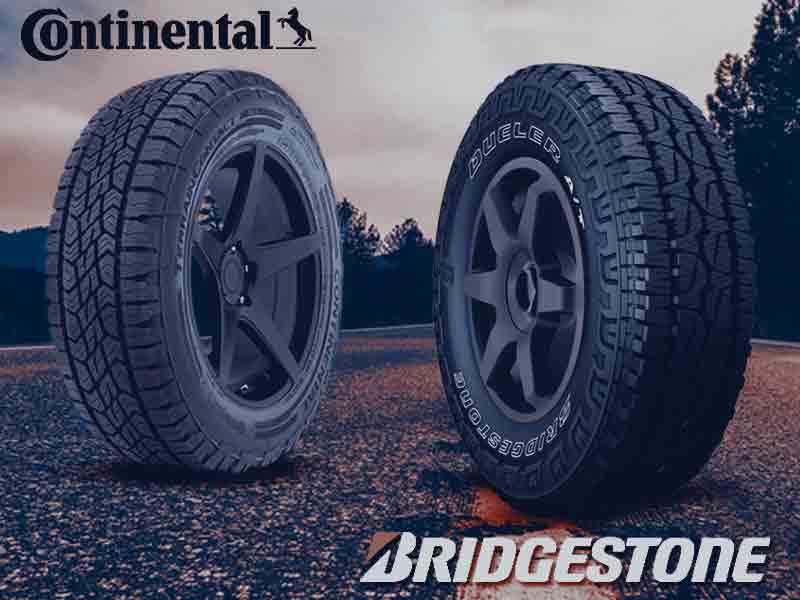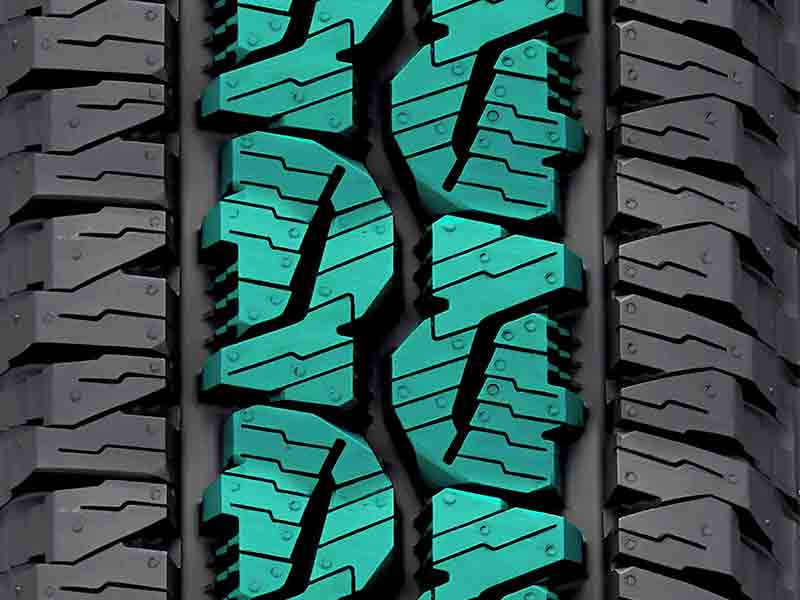Here we’re comparing the two great on-road oriented all terrain tires, the Bridgestone Dueler A/T Revo 3 and the Continental TerrainContact AT.
To sum up, Continental TerrainContact AT excels in dry and wet traction and mud performance, while the Bridgestone Dueler A/T Revo 3 outperforms in sandy and rocky terrains.

Let’s explore their features, strengths, and what sets them apart.
Table of Contents
Design and Structure
Continental TerrainContact AT is designed with a strong on-road orientation, featuring five ribs in a closed structure. The central rib has wider lugs with slanted rectilinear siping and curved in-groove notches, providing stability through longitudinal connections.

While the surrounding ribs feature paired lugs with similar siping as well as sharp saw-tooth biters, known as snow vices, on the outer edges.
The shoulder lugs are the largest though, forming a squared-off structure with wave-like siping and unstaggered outer margins.
On the flip side, the Bridgestone Dueler Revo 3 is a less aggressive A/T tire here, with two central ribs containing a repeating block design.

These lugs have sharp in-groove notches, rectilinear sipes, offset edges, and saw-tooth biters that face the shoulders, And all these lugs form three circumferential grooves in the middle.
Moving towards shoulders, the lugs here sit on a continuous rib, equipped with notches and thicker siping. Plus they also form relatively more effective sidewall lugs in comparison as well.
Have a quick look at their specs.
| Feature | Bridgestone Dueler A/T Revo 3 | Continental TerrainContact AT |
|---|---|---|
| Rim Sizes | 16 to 20 inches | 16 to 20 inches |
| Speed Ratings | S, R, T | S, T, H, V (one size) |
| Load Ratings | SL, C, E | SL to E |
| Weight Range | 30 to 60 lbs | 28 to 66.5 lbs |
| Tread Depth Range | 12 to 16/32″ | LT sizes: 16/32″, P metric: 12/32″ |
| Warranty | 60k miles (non-LT sizes) | 60k miles |
| Winter Rating | Not rated with 3 peak mountain snowflake | M+S |
Dry Traction
All-terrain tires are generally less capable on highways compared to all-season or touring tires. However, both AT tires here offer superb capabilities.
Yet getting in to detailed tests, you get to see the TerrainContact AT still providing you with better overall dry performance.
In terms of braking which highly depends on the tread’s central area, the Continental provides shorter stopping distances on average with its central rib that offers superior stability.
Whereas Dueler AT tire lacks in this area due to its curvy longitudinal channel. For handling, which depends on tread flexibility and shoulders, the TerrainContact takes the upper hand.
Its more balanced tread compound provides a better blend of stiffness and flexibility, enhancing steering sensitivity.
That’s why its the only all terrain tire with the largest speed rating going up to V, whereas the Bridgestone Revo 3 only provides up to T.
Wet Traction
Wet grip or traction depends on the tread’s flexibility and siping. In other words, With higher silica density, which produces softer rubber, and ample sipes, a tire achieves better wet performance.
That’s why the Continental TerrainContact A/T excels here offering a better suited rubber and a greater number of sipes with two different patterns that is (interlocking on shoulder blocks and rectilinear on central blocks).
These patterns enhance the tire’s water wiping abilities and maintain flexibility during cornering as well as braking.
On the other side, the Bridgestone Dueler A/T Revo 3 does not offer as effective of a siping structure, but yes the tire has similar hydroplaning resistance in comparison i can give you that.
So overall Dueler lacks in wet traction and handling but it still delivers very similar float speeds on average.
Winter Traction
Despite not having a 3 Peak Mountain Snowflake (3PMSF) rating, both tires perform well in mild snowy conditions.
However, at the end of the day, the Bridgestone Revo 3 provides greater overall winter performance.
This is because the tire offers numerous biters in the form of in-groove notches, sharp edges on the outer circumferential grooves, and thick siping that suits winter conditions better relatively. And all of these supply ample snow-gripping capabilities.
In other words, these elements lodge snow particles with much more ease, allowing the tire to contact the ground with them.
And since snow sticks better to snow, this increases friction and provides superior grip compared to the Continental’s tire.
Tread Noise
When it comes to all-terrain tires, our tests found the TerrainContact A/T to be the quietest in its category.
In fact being the quietest it made to our list of best all terrain tires video. be sure to check it out just click on the top right corner to watch it.
Now noise on roads mainly comes from air pumping in and out of the tread grooves as the tire rolls.
And the Continental AT addresses this in two great ways:
First off the shoulder lugs on the TerrainContact A/T are very packed up with more effective ridges in the lateral voids restricting a lot of air from entering to begin with.
And then the remaining air particles hitting the tread is managed by pitch sequencing or as some like to call variable pitch technology.
This tech has to do with the varying shapes of the tread blocks which create different frequencies when air particles collide with them, and those varying tones and frequencies cancel each other out, making this tire quieter .
Fuel and Tread Economy
A tire with higher rolling resistance uses more fuel and wears out faster. This resistance depends largely on the tire’s weight and its ability to detach from the surface, or its stickiness.
Now out of both tires here, the Bridgestone Dueler AT Revo 3 performs slightly better in terms of fuel economy and tread longevity.
Despite having a weight similar to the Continental tire, its bulkier tread blocks distribute weight more effectively, reducing the impact on each lug and lowering friction.
Additionally, as discussed in the dry performance section, the tire’s lower grip and speed ratings may reduce overall traction, but they benefit fuel efficiency and tread life by reducing rolling resistance.
Off Road Traction
Off-road involves there are three terrain types: sand, mud, and rocks. Let’s take a closer look at each of them.
Sandy Terrains
On sandy terrain, a tire needs a softer tread and lighter weight to enhance its floating abilities. The Continental TerrainContact AT falls short in this area due to its heavier structure and lack of sidewall lugs.
This design makes it less effective at maintaining traction and flotation on sand.
In contrast, the Bridgestone Dueler Revo 3, although featuring sidewall lugs that are not very thick, has a design that covers a larger surface area.
When air pressure is lowered, these lugs spread out more effectively, increasing the tire’s contact patch and enhancing its floating abilities.
This makes the Dueler Revo 3 superior for sandy terrains, providing better performance and stability compared to the Continental TerrainContact AT.
Mud
On muddy tracks, especially deeper ones, tires need plenty of voids to clean the tread from thick, sticky clay. Both the Continental TerrainContact AT and the Bridgestone Dueler Revo 3 have packed outer shoulder lugs that restrict the mud’s sideways flow.
However, if you have to pick one for muddy conditions, the Continental is the better choice.
The TerrainContact AT performs slightly better due to its superior interlocking middle section with smaller blocks. This design is particularly effective in cutting down mud particles and preventing them from packing tightly between the lugs.
The interlocking pattern of the central blocks creates more pathways for mud to be expelled, enhancing the tire’s self-cleaning capabilities.
By cutting the mud particles down into smaller pieces, the TerrainContact AT facilitates quicker evacuation of the mud from the tread. This reduces the risk of mud clogging and helps maintain traction even in thick, sticky conditions.
This feature makes the Continental TerrainContact AT more reliable for maintaining grip and performance on muddy tracks compared to the Bridgestone Dueler Revo 3.
Rocks
Climbing rocky terrain demands durability and grip from multiple angles, and this is an area where both the Continental TerrainContact A/T and the Bridgestone Dueler A/T Revo 3 perform equally well.
The TerrainContact A/T features a well-designed middle section that provides excellent longitudinal and lateral grip. This is achieved through multiple-angled in-groove notches that enhance traction on rocky surfaces.
These notches create additional biting edges that improve grip when climbing over rocks, ensuring that the tire can maintain contact with the terrain from various angles.
On the other hand, the Dueler A/T Revo 3 excels with its superior sidewalls and sharp shoulder biters. The sidewalls are reinforced to withstand the harsh impacts of rocky terrains, providing additional durability and resistance to punctures.
The sharp shoulder biters enhance traction by gripping the rocks more effectively, especially when the tire pressure is lowered.
This increased surface area and better contact patch allow the tire to conform to the shape of the rocks, offering improved stability and grip.
Moreover, the Dueler A/T Revo 3’s sidewall lugs are strategically designed to provide extra traction on rocky trails, ensuring the tire can handle both vertical and horizontal stresses.
The combination of robust sidewalls and aggressive shoulder design makes it highly capable in rock climbing scenarios.
Both tires, with their unique designs, offer exceptional performance on rocky terrains. The TerrainContact A/T provides a balanced grip with its middle section, while the Dueler A/T Revo 3 delivers superior traction through its reinforced sidewalls and sharp shoulder biters.
Conclusion
In conclusion, the Continental TerrainContact A/T excels in dry and wet traction, providing better handling and quieter on-road performance.
It also performs well in muddy conditions due to its superior mud evacuation design. Bridgestone Dueler A/T Revo 3 shines in sandy terrains with effective sidewall lugs and offers robust performance on rocky terrains thanks to its reinforced sidewalls and sharp shoulder biters.